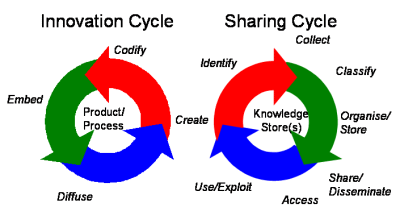Knowledge Life Cycles
In the analysis of over 100 KM programmes for
the book Knowledge
Networking[1], two main approaches were
identified:
- Better sharing of existing knowledge - knowing what you know. Examples include sharing best practice, avoiding "reinventing the wheel", and the use of intranets as portals into core knowledge that is widely shared.
- Faster or smarter innovation - creating and commercializing new knowledge. This involves converting ideas into valuable products, services or processes, either internally or for external sale.
We can represent the evolution of knowledge in
these two approaches as two life cycles:
 Please note - these are generic and high level
representations. In practice, continual
iteration through different levels of
aggregation means that the actual paths between
specific processes are often more complex than
those shown.
Please note - these are generic and high level
representations. In practice, continual
iteration through different levels of
aggregation means that the actual paths between
specific processes are often more complex than
those shown.
The Innovation Cycle
This shows the evolution the generation of
ideas (unstructured knowledge) into more
structured and reproducible knowledge, embedded
within processes or products. Some of the key
processes are:
- Create. An idea for a new product, process or strategy is created. These are discussed and formalised to initiate a new cycle of innovation.
- Codify. The ideas are codified, such as in a product design or a process description. The original idea is now more structured and transferable.
- Embed. At this stage (for a product) the knowledge is encapsulated in a prototype, or for a process made part of an organizational procedures.
- Diffuse.Products reach the market; processes are widely practiced throughout the organization. Application of the embedded knowledge generates ideas for improvements, and so the cycle repeats.
The Knowledge Sharing Cycle
These are the processes associated with
gathering and disseminating existing knowledge.
For most KM programmes, this is the primary
focus. Knowledge is stored in one or more
repositories, such as computer storage for
explicit knowledge and people's heads for
tacit knowledge. The descriptors below relate
mostly to explicit knowledge. In our pages on
information management (forthcoming) we show a
more complete variation of this cycle using IM
terminology - the Information Life Cycle.
- Create/collect. New knowledge is created or existing knowledge is gathered. A knowledge audit is a good technique for discovering what exists.
- Organize/store. The knowledge is classified and stored, perhaps using a company specific taxonomy. This makes subsequent retrieval easier.
- Share/disseminate. Information may be 'pushed' to people as part of routine dissemination or it may be simply 'parked' in information repositories for individuals to access it when needed. For tacit knowledge, this part of the cycle involves knowledge transfer activities such as meetings.
- Access. Individuals browse or search their organization's information and document repositories, typically via an intranet. Users 'pull' the information when they need it.
- Use/exploit. They use this knowledge to carry out specific tasks. As they use it the knowledge is evaluated, refined and improved. As a result new knowledge is created and the cycle repeats.
Implications
The knowledge cycles provide a good basis for
considering the effectiveness of various
information and knowledge development and
sharing processes. In particular they can be
useful for:
- Pinpointing areas of strength and weaknesses, and hence what skills or systems need improvement
- Creating dialogue over how different people and different parts of the organization manage their information and knowledge
- Identifying particular bottlenecks in information and knowledge processing
- Highlighting opportunities to capture and disseminate best practice in information and knowledge management.
As an example of the latter, I used the
knowledge sharing cycle (expanded with
additional and more specific processes) in a
workshop with a professional group of one of my
clients. For each process, a group of two or
three were instructed to find out more about
the techniques involved and find examples of
best practice within their organization. This
htye then wrote up a short guide and presented
their findings at a subsequent workshop. All
were amazed at how much good KM practice was
actually going on in particular pockets within
their organization, but which had not been
formally documented or widely communicated.
1. Knowledge networking: Creating the
Collaborative Enterprise, David J Skyrme,
Butterworth-Heinemann (1999). See Knowledge
Networking pages (archive site with
updates).
Deepa Singh
Business Developer
Web Site:-http://www.gyapti.com
Blog:- http://gyapti.blogspot.com/
Email Id:-deepa.singh@soarlogic.com
Deepa Singh
Business Developer
Web Site:-http://www.gyapti.com
Blog:- http://gyapti.blogspot.com/
Email Id:-deepa.singh@soarlogic.com
No comments:
Post a Comment